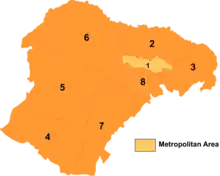Ordos
See also: ordos
English

map showing relation of the Ordos Loop with modern Chinese provinces (fertile Loess Plateau shaded)

map of Ordos prefecture-level city, the built-up area in the narrower sense located in the eastern Dongsheng District (highlighted in yellow)
Etymology
From Classical Mongolian ᠣᠷᠳᠣᠰ (ordos, “palaces”), from Classical Mongolian ᠣᠷᠳᠣ (ordo, “palace”) + ᠊ᠰ (-s, plural suffix); probably from Proto-Turkic *or- (“army, place of staying of the army, ruler etc.”). Originally in reference to the portable mausoleums of Genghis Khan (known as the "eight white yurts"), which were used following the fall of the Yuan dynasty in 1368. These were entrusted to caretakers, who worshipped at the mausoleums as the "soul guards" of the khan, and who moved to the Ordos plateau in the years following. After a time, both the people and their territory took the name, due to the presence of the mausoleums there.
Pronunciation
The template Template:rfp does not use the parameter(s): 3=enPlease see Module:checkparams for help with this warning.
Proper noun
Ordos
- A region of China, enclosed by the great northern bend of the Yellow River and the Wei River to the south; also called Ordos Loop.
- 1956, Theodore Shabad, China's Changing Map: A Political and Economic Geography of the Chinese People's Republic, New York: Frederick A. Praeger, →LCCN, →OCLC, →OL, page 246:
- The Chinese Moslems, who constitute the largest minority, number about 700,000. They are organized in two autonomous chou and three autonomous hsien. The Wuchung Moslem Autonomous Chou, situated east of the Yellow River in former Ningsia Province, was called the Hotung (“east of the river”) chou until April, 1955, when it was renamed for its capital. The Wuchung chou has a population of 230,000, 62 per cent of whom are Moslems. The Wuchung chou includes the east-bank section of the Ningsia irrigated plain, adjoins the Ordos desert and passes southeastward into the loesslands. The autonomous chou was set up in April, 1954.
- 1970, T. R. Tregear, An Economic Geography of China, Butterworths, →ISBN, →OCLC, page 60:
- The river, which is some 3,028 miles long and has a catchment basin of 250,000 sq. miles, rises in the Bayan Kara Shan (15,000 ft) of north-east Tibet and flows as a mountain torrent above Lanchow. Between Lanchow and Wuchung in Ningsia it descends on to the Inner Mongolian plateau and is less torrential although still of considerable strength. At Wuchung it starts on its northward course, known as the Great Bend, across the Ordos Desert.
- The Ordos region proper: the area north of the Great Wall section that cuts across the Ordos Loop
- The Ordos region in the narrower sense is nomadic by history, in contrast to the agricultural and densely populated southeastern loess part that stretches up to the Wei River valley.
- Ordos prefecture-level city, contiguous with latter region in the northwest of the Ordos Loop, namely the part belonging to Inner Mongolia.
- Kangbashi District, the famous Chinese newly-built ghost town, lies in the mineral-rich region of Ordos, more precisely 25 km away from Dongsheng built-up area in Dongsheng District, the municipal seat.
- 2011, Eric Enno Tamm, The Horse that Leaps through Clouds, Counterpoint Press, →ISBN, →LCCN, →OCLC, →OL, page 388:
- That prompted Buhchulu to quote yet another saying of this medieval eco-crusader: "'Don't freely dig up the earth!'"
FREELY DIGGING UP the earth is exactly what I saw during a long, numbingly cold bus ride the next day to Genghis Khan’s mausoleum in the heart of the Ordos prefecture.
- 2012, Steve Cortés, Against the Herd, John Wiley & Sons, →ISBN, →OCLC, page 14:
- One rather frightening place those cars and bridges can reach is the Ghost City of Ordos. The original old Ordos lies on top of one-sixth of all the coal reserves of China. So despite its remote location near the Mongolian border, Ordos prospered. Its citizens produced about three times the national average GDP of China, ranking it only behind Shanghai and ahead of Beijing. Ordos became known as China’s Texas.
- 2012 March 17, Peter Day, “Ordos: The biggest ghost town in China”, in BBC, archived from the original on March 5, 2014:
- In Inner Mongolia a new city stands largely empty. This city, Ordos, suggests that the great Chinese building boom, which did so much to fuel the country's astonishing economic growth, is over.
- 2014, Alastair Bonnett, “Kangbashi”, in Unruly Places: Lost Spaces, Secret Cities, and Other Inscrutable Geographies, 1st U.S. edition, Houghton Mifflin Harcourt, →ISBN, →LCCN, →OCLC, page 100:
- As we have come to see, places have power, and power is symbolized by its possession of place. The deep bond between the two is especially clear in empty landscapes, such as the ghost town of Kangbashi New Area in the Chinese city of Ordos.
- 2015 March 6, Jody Rosen, “The Colossal Strangeness of China’s Most Excellent Tourist City”, in The New York Times, →ISSN, →OCLC, archived from the original on 17 September 2015:
- In 2006, the headquarters of the local government was moved to Kangbashi from the Dongsheng District, 20 miles north; bus service between Kangbashi and Dongsheng was allegedly cut off so that Ordos’s public officials would be forced to take up residence in the new town.
- Ordos city in the narrower sense: the urban area located in Dongsheng District.
- A Mongolian dialect used in this city.
Synonyms
- (from Mandarin Chinese) E'erduosi
Translations
Further reading
- Ordos, E'erduosi, Eerduosi at Google Ngram Viewer
- Saul B. Cohen, editor (1998), “Ordos Plateau”, in The Columbia Gazetteer of the World, volume 2, New York: Columbia University Press, →ISBN, →LCCN, →OCLC, page 2296, column 3
- “Ордос”, in Монголын Туухийн Тайлбар Толь [Dictionary of Mongolian History] (in Mongolian), Institute of Linguistics of the Mongolian Academy of Sciences, 2016–present
This article is issued from Wiktionary. The text is licensed under Creative Commons - Attribution - Sharealike. Additional terms may apply for the media files.